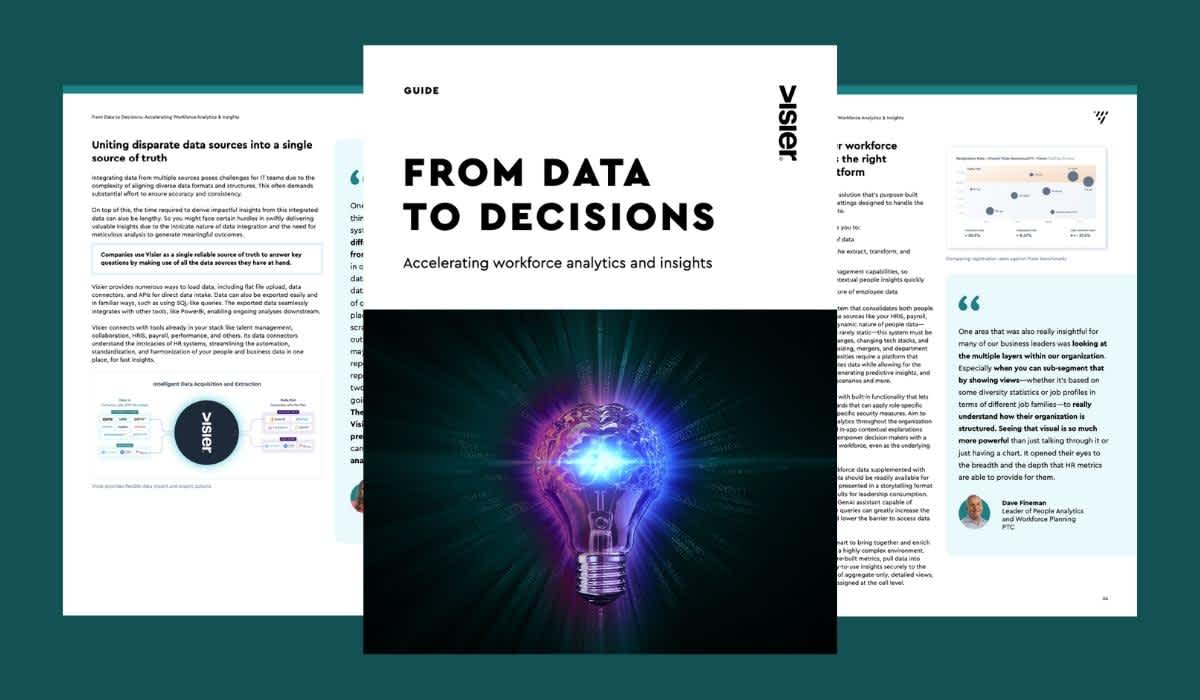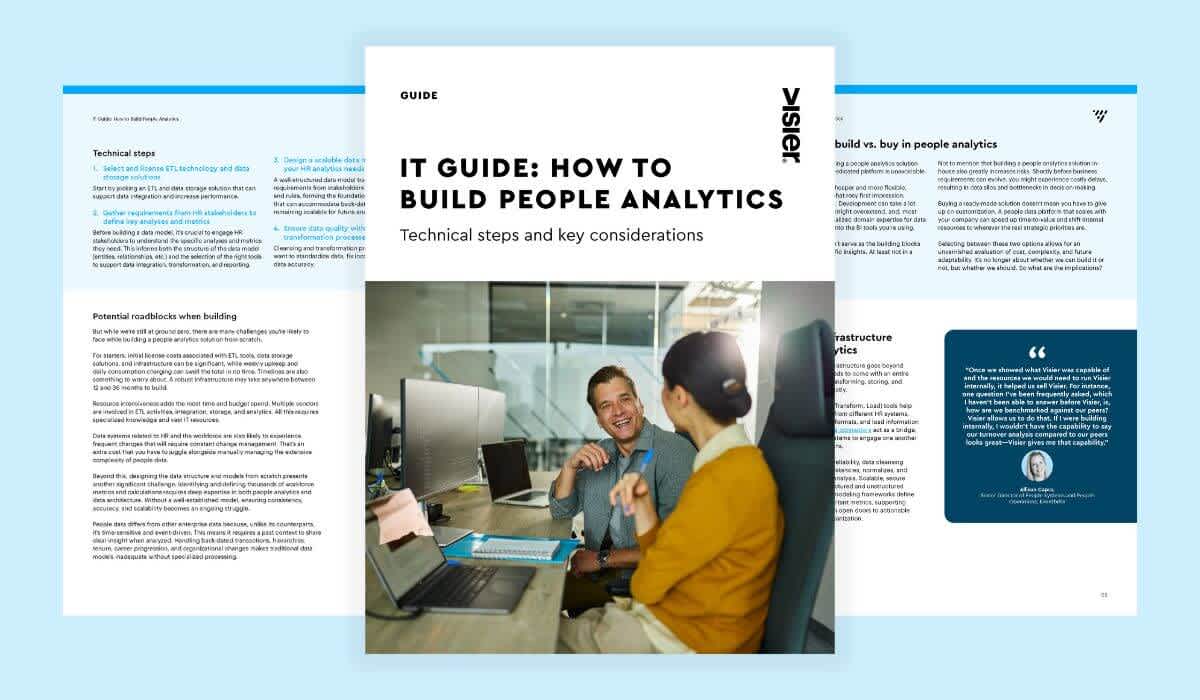Employee Data Management: Benefits, Roles, and Process
Employee data management involves collecting, organizing, and storing employee information for strategic purposes. Read on to learn more.

Your employees are one of your greatest strengths that can be wasted if you don’t make data your ally. With an ever-growing data ecosystem and large volumes of information at our fingertips, this can be challenging.
You gather more information day after day. Before you know it, chaos sets in and your data is unreliable. Employee data management helps you keep information organized, up-to-date, accessible, and reliable. Here’s everything you need to know about it.

What is employee data management?
Employee data management means collecting, organizing, and storing employee data. The bigger the company, the more employee data you get to work with. From addresses and other demographic details to performance reviews and exit interviews, the data volumes add up quickly.
Human error is a common data management challenge. There’s missing information on one side and duplicates or outdated entries on the other. Employee data management helps you make sense of the chaos, giving you a structured way of collecting and organizing your data.
With it, you can avoid common issues like incorrect or missing data. You can also store everything in a format that will be easy to access and use for people analytics. Employee data management in HR is essential for companies that want to switch to a data-driven model, make informed decisions, and reach business goals faster.
5 benefits of employee data management
Employee data management helps you make sense of one of your most valuable assets—data. Some benefits include:
It saves time. Once implemented, employee data management can speed up processes like data collection, storage, and analysis.
It shows you a complete view of your workforce. Your workforce is more than a headcount. With employee data management, you can understand who your employees are, how well they perform, how long they have been in their current position, and more.
It helps you stay compliant. Data privacy regulations are becoming stricter (e.g. see new ESG reporting requirements). Without effective data management, you’re at risk of experiencing data breaches, violating regulations, and paying hefty penalties.
It helps you identify workforce trends. Employee data management helps you spot positive and negative trends within your workforce. You might notice most employees leave after two years or that engagement decreases after one year. You can then use these observations to understand what drives the changes and take steps to improve these trends.
It boosts efficiency. When you don’t have to waste hours or even days figuring out where the data you need is or if it’s even correct, you can focus on what truly matters for your business. Plus, if you automate things like data collection and storage, you free up more time to focus on more impactful things in your company.
Employee data management roles and responsibilities
Employee data management should never be a one-person job. Several stakeholders and team members should be involved, from multiple departments.
1. Data and HRIS teams
Data and HRIS (Human Resources Information Systems) teams are instrumental in managing employee-related information within an organization. These teams are instrumental in collecting, organizing, and analyzing vast amounts of employee data, ensuring its accuracy, and preparing it for analysis. They implement and maintain the technology systems used to store and manage this data efficiently and securely.
2. The HR team
HR is the department that works with employee data most often, so they’ll be the most involved in the data management process. Key roles include:
HR specialist. Depending on the size of the company, you may need several people in this role. They’ll ensure data accuracy and confidentiality and may also update employee records and ensure a transparent collection of data.
Employee relations specialist. This is the person who will handle any concerns employees may have related to data privacy. They’ll also help communicate HR policies and maintain a positive work environment.
3. Compliance officer
You can’t think of personal data without considering regulatory compliance. A compliance officer will ensure all HR practices align with privacy regulations. They will oversee collection and storage practices, prioritizing employees’ rights.
4. Security officer
Data privacy and compliance go hand in hand with data security. That’s where the security officer comes in, ensuring there are sufficient measures in place to prevent a data breach. They may also check access rights and other security protocols.
5. Training manager
The training manager will help train HR and other relevant staff about data management best practices. They may also collaborate with the compliance and security officer respectively to help employees understand privacy and security protocols.

6 employee data management best practices
Employee data management is an essential process for any business. But using it might feel challenging at first. Here are some best practices that will help you get started on your journey.
1. Assess the data you have
Before you can think of collection, storage, and analysis, you need to identify the data you have. What type of data do you collect? How and when do you collect it? Where is it stored?
Validation plays a critical role in ensuring your data's accuracy and reliability. This includes checking for inconsistencies, duplicates, or missing information that could distort insights. Tools for data validation proactively flag issues during uploads/updates so you can maintain clean and trustworthy datasets.
2. Set your goals
Knowing your goals will help you gain clarity about what type of data you should focus on. Make them realistic and measurable to help you keep track of your progress on strategic workforce planning.
Incorporate a feedback loop to evaluate whether the data you're collecting and analyzing effectively supports your goals. Adjust objectives as needed to respond to evolving business requirements, technological advancements, or new compliance mandates.
3. Categorize data
Knowing your data and your goals are the first steps. But for effective data management, you need to take it one step further and create data segments or categories. These will help you save time by accessing the right data faster.
Customization further amplifies the power of categorization. With Visier’s Analytic Model, you can modify existing metrics, create new attributes, or integrate additional data sources to meet unique business challenges.
For instance, you can opt to adjust performance thresholds to explore new insights, integrate sales data to see its impact on revenue, or design custom objects to understand employee influence on customer satisfaction. Such custom adjustments keep your analytics relevant and actionable, providing deeper insights into workforce dynamics.
4. Restrict access
Employee data is personal and often sensitive. Restricting who has access to it is a necessary security measure for your employees’ safety and compliance with privacy regulations.
With Visier’s Permission Management and Data Access Sets, you can define detailed or aggregate access to metrics, attributes, and calculated properties. These configurations give you a more flexible and secure approach to managing who can access specific data, ensuring privacy while enabling tailored insights.
5. Choose a data management tool
Employee data management is not a task you should carry out manually. Find a tool that automates the repetitive processes, reducing human error, and enabling more strategic decision-making. Forward-thinking companies choose AI-ready people data platforms that unify data sources, providing advanced insights and fostering a more dynamic analytical environment.
These platforms go beyond basic reporting by transforming raw data into actionable insights. They adapt to emerging patterns, predict workforce trends, and empower leaders to shape organizational strategies with precision.

6. Train your employees
Offer extensive training to those who will work directly with data. Help them learn how to use the tools and what the best practices behind handling data and staying compliant are.
Additionally, ensure they are well-versed in data handling best practices, covering key topics such as data classification, encryption, secure sharing protocols, and maintaining audit trails. Emphasize adherence to regulatory requirements and industry standards, such as GDPR, HIPAA, or SOC 2, to ensure compliance and minimize risks.
The employee data management process
The employee data management process will look different from company to company. Many variables come into play, such as how much data you have, your goals, your tools, and your analytics practices. There are, however, a few steps that you’ll encounter in most employee data management processes.
1. Audit your current data management techniques
Before creating a new process, you must look at your current one and ask yourself:
How are you collecting data?
Where are you storing it?
Can you notice any areas that are giving you a hard time, where mistakes are happening, or where you waste a lot of time?
Getting a benchmark of where you are currently, and where the challenges lie, will help you identify improvement opportunities.
2. Assess and categorize all your data
Understanding the type of HR data you use is important both for regulatory compliance but also for your internal processes. Common types include:
Personnel information you’ll commonly find in an employee file
Medical information including drug tests, parental leave, and other things related to an employee’s work
Payroll information, which usually includes sensitive information related to payment
Demographic data, such as addresses and other relevant information
Job-related skills
Training and other learning and development programs a person was involved in
Data related to employee performance
3. Improve data collection and storage practices
If you’ve given little thought to employee data management until now, chances are your collection and storage practices have room for improvement. Look back to step one to find the areas most prone to mistakes or where the process feels too slow.
See what you can automate and what needs to remain a manual operation. Most companies will automate the data collection process, but activities like pre-processing, organizing, and storing can also be fully or partly automated.
4. Conduct regular audits
No matter how good your process is, mistakes can happen. Conducting regular audits will ensure everything works correctly, and that the quality of the data is the best. Look at your goals and various other HR metrics and KPIs to see if everything works as expected.

What to look for in an employee data management system
With evolving AI and tech needs, selecting an employee data management system (EDMS) depends a lot on your goals and your current systems. Your system should have a few things if you want the best results:
Scalability
Expect the amount of data to grow in time, especially as AI tools enable more detailed data capture and processing. Choose a system designed for high-volume, high-speed data management to avoid bottlenecks as your organization expands. Look for cloud-based solutions or hybrid models with elastic scaling capabilities to handle increased workloads efficiently.
Integrations
Integration remains key, but the focus now extends to compatibility with AI-powered analytics and automation platforms. Ensure your EDMS can seamlessly incorporate employee data, HR analytics, payroll systems, and business intelligence tools driven by machine learning for deeper insights. AI-enabled integrations can also streamline workflows by automating repetitive tasks like data entry or reporting.
User access control
Unless you can restrict who has access to data, you’re at an increased risk of a data breach. Select a system that not only allows role-based permissions but also uses AI to monitor and flag unusual access patterns in real time. This proactive approach to access management can prevent breaches before they occur.
Data security
With increasing sophistication in cyber threats, your system must have robust security features. AI-enhanced cybersecurity measures such as behavior-based threat detection, encrypted data transfers, and real-time anomaly detection are now essential. This can help protect sensitive employee data from modern attack vectors like deepfakes or AI-generated phishing attempts.
Compliance features
As privacy regulations grow stricter worldwide, compliance is no longer optional. Modern EDMS solutions often include automated compliance monitoring features to help you adhere to GDPR, CCPA, and newer regulations.
Data backup and recovery
While traditional backups are crucial, AI-enhanced systems now offer predictive failure analysis. These tools can identify and address potential system vulnerabilities before a failure occurs, ensuring continuous uptime and safeguarding against data loss.
Employee data management is the first step towards making more data-informed decisions. It will help you analyze data, understand what drives your employees, and how you can improve performance and productivity, and reach business goals.
Download the full report to explore the strategies and insights needed to lead in a future defined by AI-driven work.
Read more about employee data management
Get the data management guide to learn how to bring disparate data together from multiple sources, automatically standardize and normalize it, and shave years off their delivery schedule to reduce total cost of ownership.
Integrate disparate people data and work data into a unified model for downstream analysis and AI. Find out more about data engineering for workforce analytics.
Visier administrators have multiple data management options available inside and outside the Studio environment that make it easier to customize, load, and export data. Read the docs to learn more.



